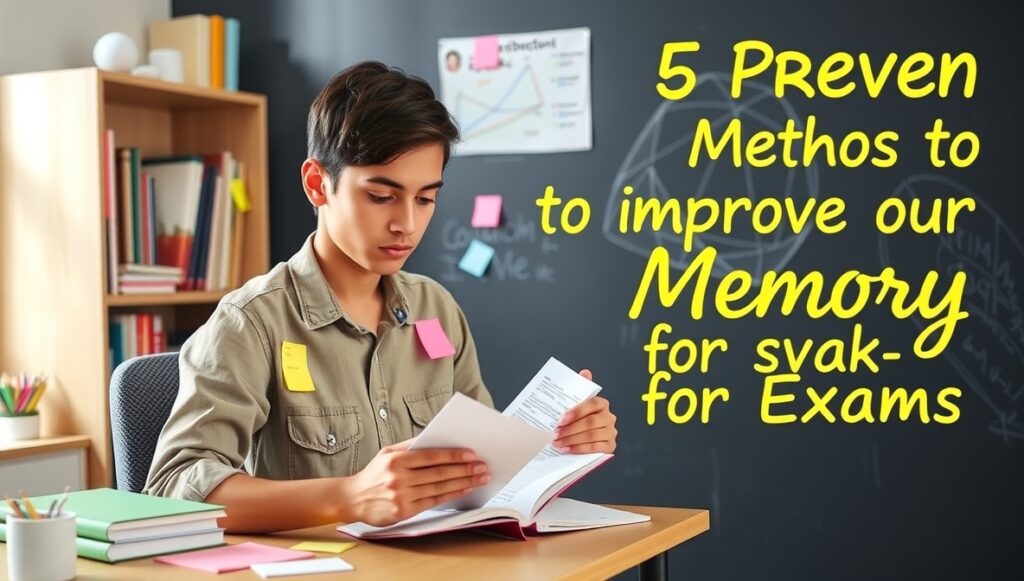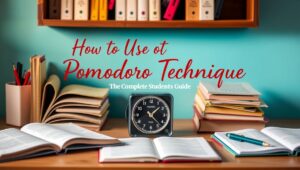Memory is the cornerstone of academic success, yet most students rely on ineffective memorization techniques that waste time and produce poor results. While many believe that some people are simply born with better memories, neuroscience research reveals that memory is actually a skill that can be dramatically improved through specific, evidence-based techniques. The difference between students who effortlessly recall information during exams and those who struggle isn’t natural ability—it’s the strategic application of proven memory enhancement methods.

This comprehensive guide explores five scientifically validated techniques that can transform your memory performance and exam results. These methods aren’t theoretical concepts but practical tools backed by decades of cognitive psychology research and proven effective by millions of students worldwide. By understanding how memory works and implementing these strategies, you can move from passive memorization to active memory mastery, achieving better grades while spending less time studying.
Understanding Memory: The Foundation of Effective Learning
Before diving into specific techniques, it’s crucial to understand how memory actually works. Memory isn’t a single process but rather a complex system involving three distinct stages: encoding (getting information into your brain), storage (maintaining that information over time), and retrieval (accessing the information when needed).
The Three Memory Systems:
Sensory Memory holds information for mere seconds, filtering what deserves attention. Most study material never makes it past this stage because it fails to capture meaningful attention.
Short-Term Memory (or working memory) can hold approximately 7 pieces of information for 15-30 seconds without rehearsal. This is where most cramming occurs—and why it’s so ineffective for long-term retention.
Long-Term Memory has virtually unlimited capacity and can store information indefinitely, but only when material is properly encoded through meaningful processing and repeated retrieval.
The key insight from memory research is that information must be actively processed and repeatedly accessed to move from short-term to long-term storage. Simply re-reading notes or highlighting text engages only surface-level processing, which explains why these popular study methods produce such poor results.
Method 1: Spaced Repetition – The Memory Multiplication System
Spaced repetition represents perhaps the most powerful memory enhancement technique available, yet it’s criminally underutilized by most students. This method leverages the psychological spacing effect, discovered by Hermann Ebbinghaus in 1885, which demonstrates that information reviewed at increasing intervals is remembered far longer than information studied in massed sessions.
The Science Behind Spaced Repetition
When you learn something new, your brain forms neural pathways. Without reinforcement, these pathways weaken rapidly—you forget approximately 50% of new information within one hour and 90% within one week. However, each time you successfully recall information, you strengthen these neural pathways and extend the forgetting curve. Spaced repetition exploits this biological reality by scheduling reviews at the optimal moments just before you’re likely to forget.
The Optimal Spacing Intervals:
Research has identified specific intervals that maximize memory retention:
- First review: 1 day after initial learning
- Second review: 3 days after first review
- Third review: 1 week after second review
- Fourth review: 2 weeks after third review
- Fifth review: 1 month after fourth review
- Sixth review: 3 months after fifth review
Implementing Spaced Repetition for Exam Success
Digital Implementation:
Modern spaced repetition software automates the scheduling process, making this technique incredibly practical for busy students.

Anki (most powerful): Create digital flashcards with questions on one side and answers on the other. The algorithm automatically schedules reviews based on how well you remember each card. Cards you forget are shown more frequently, while cards you remember easily are spaced further apart.
Quizlet (most user-friendly): Offers built-in spaced repetition features with various study modes including games and practice tests. Particularly effective for vocabulary and basic fact memorization.
SuperMemo (most advanced): The original spaced repetition software with sophisticated algorithms, ideal for serious students willing to invest time in setup.
Manual Implementation:
For students preferring physical study materials, create a simple box system:
- Box 1: New cards reviewed daily
- Box 2: Cards mastered once, reviewed every 3 days
- Box 3: Cards mastered twice, reviewed weekly
- Box 4: Cards mastered three times, reviewed monthly
- Box 5: Cards mastered four times, reviewed before major exams only
When you correctly recall a card, move it to the next box. When you get it wrong, move it back to Box 1.
Maximizing Spaced Repetition Effectiveness
Create Effective Cards:
- One concept per card to avoid cognitive overload
- Use questions that require active recall, not passive recognition
- Include context and connections to other concepts
- Add visual elements when possible to enhance memory encoding
Consistency is Key:
- Review cards daily, even if only for 10-15 minutes
- Don’t skip review sessions, as this disrupts the spacing algorithm
- Start spaced repetition early in the semester, not just before exams
- Continue reviewing even after you feel confident with material
Advanced Techniques:
- Create reverse cards (answer to question and question to answer)
- Use elaborative interrogation by asking “why” and “how” questions
- Connect new information to existing knowledge through associative cards
- Include application-based questions that test understanding, not just recall
Method 2: The Memory Palace Technique – Ancient Wisdom for Modern Learning
The Memory Palace technique, also known as the Method of Loci, is perhaps the oldest and most powerful memory system known to humanity. Used by ancient Greek and Roman orators to memorize hours-long speeches, this technique leverages your brain’s exceptional ability to remember spatial information and visual imagery.
The Neurological Foundation
Your brain contains specialized cells called place cells and grid cells that create detailed mental maps of familiar environments. These spatial memory systems are incredibly robust—you can likely navigate your childhood home in complete darkness even years later. The Memory Palace technique hijacks these powerful spatial memory networks to store academic information.
Scientific Validation:
- Memory athletes using spatial techniques can memorize the order of shuffled playing cards in under 30 seconds
- Studies show 90%+ retention rates for information encoded using memory palace techniques
- fMRI research reveals that memory palace users engage both spatial and verbal memory networks simultaneously
Building Your Memory Palace
Step 1: Choose Your Locations
Start with familiar places you know intimately:
- Your family home (most effective for beginners)
- Your school campus or specific buildings
- Your regular commute route
- Frequently visited locations (gym, store, friend’s house)
Step 2: Define Your Route
Create a specific path through your chosen location:
- Always follow the same direction (clockwise recommended)
- Choose 10-20 distinct locations along your route
- Ensure locations are evenly spaced and visually distinct
- Practice walking the route mentally until automatic
Example Route Through a House:
- Front door entrance
- Hallway coat closet
- Living room couch
- Kitchen table
- Kitchen sink
- Refrigerator
- Dining room chair
- Stairs (bottom)
- Bathroom mirror
- Bedroom bed
Step 3: Create Vivid Associations
Transform abstract information into memorable images:
- Make images bizarre, funny, or emotionally engaging
- Use action and movement rather than static pictures
- Connect new information to objects already in your locations
- Engage multiple senses (sight, sound, smell, touch)
Subject-Specific Memory Palace Applications
History Dates and Events:
To remember that World War I began in 1914, you might visualize:
- Walking through your front door (Location 1)
- Seeing a massive war scene with soldiers from 1914 fighting in your entryway
- The number “1914” written in mud on your door
- Hearing the sounds of artillery and seeing period-accurate uniforms
Scientific Processes:
For photosynthesis steps:
- Location 1 (Front door): Sunlight streaming through, representing light absorption
- Location 2 (Coat closet): Green coats hanging, representing chlorophyll
- Location 3 (Living room): Plants “breathing in” CO2 from the air
- Location 4 (Kitchen table): Sugar packets scattered everywhere, representing glucose production
- Location 5 (Kitchen sink): Water flowing, representing H2O splitting
Language Vocabulary:
For learning Spanish vocabulary:
- Location 1: “Puerta” (door) – visualize an enormous wooden door with “PUERTA” carved into it
- Location 2: “Armario” (closet) – see an “armored” closet with metal plating
- Location 3: “Sofá” (sofa) – imagine yourself saying “So far, so good!” while sitting
Advanced Memory Palace Strategies
Multiple Palaces:
- Create different palaces for different subjects
- Use smaller palaces (5-10 locations) for specific topics
- Develop master palaces (50+ locations) for comprehensive subjects
Palace Maintenance:
- Review your palaces regularly to maintain spatial familiarity
- Refresh images periodically to prevent fading
- Practice walking through palaces without study materials
Integration with Other Techniques:
- Combine with spaced repetition by reviewing palaces at optimal intervals
- Use active recall by walking through palaces and testing yourself
- Create story connections between locations for enhanced coherence
Method 3: Active Recall – The Retrieval Practice Revolution
Active recall represents a paradigm shift from passive consumption to active retrieval of information. Instead of re-reading notes or highlighting text, active recall requires you to close your books and retrieve information from memory. This technique is so powerful that educational researchers now consider it the single most effective learning strategy available.

The Cognitive Science of Retrieval Practice
Memory Strengthening: Each time you successfully retrieve information from memory, you strengthen the neural pathways associated with that knowledge. This “retrieval strength” is separate from “storage strength”—you might have information stored in memory but lack the ability to retrieve it during exams.
Desirable Difficulties: Active recall creates beneficial challenges that improve long-term retention. The effort required to retrieve information, even when difficult, enhances memory far more than easy recognition tasks.
Metacognitive Benefits: Active recall provides accurate feedback about what you actually know versus what you think you know. Most passive study methods create illusions of knowledge that collapse under exam pressure.
Implementation Strategies for Active Recall
The Blank Page Method:
The simplest and most effective active recall technique:
- Study a topic or chapter using your preferred method
- Close all materials and take out a blank sheet of paper
- Write down everything you remember about the topic
- Don’t worry about organization or completeness initially
- After exhausting your memory, check your notes for gaps
- Repeat the process, focusing on missed information
Progressive Complexity:
- Start with main concepts and broad themes
- Add supporting details and examples in subsequent rounds
- Include connections between different topics
- Conclude with application and analysis-level questions
Question Generation Technique:
Transform your study materials into questions:
- Create questions while reading or attending lectures
- Focus on understanding (“Why does this happen?”) rather than recall (“What is this?”)
- Include application questions (“How would you solve this problem?”)
- Generate questions at different cognitive levels (remember, understand, apply, analyze, evaluate, create)
Example Transformations:
Original text: “The mitochondria is the powerhouse of the cell because it produces ATP through cellular respiration.”
Effective questions:
- Why are mitochondria called the powerhouse of the cell?
- How do mitochondria produce ATP?
- What would happen to a cell if its mitochondria stopped functioning?
- How does cellular respiration differ from photosynthesis in terms of energy production?
Technology-Enhanced Active Recall
Digital Flashcard Systems:
- Create question-based cards rather than definition-based cards
- Use cloze deletion (fill-in-the-blank) for complex information
- Include reverse cards to test bidirectional knowledge
- Add explanation cards that require you to explain reasoning
Self-Testing Applications:
- Remnote: Combines note-taking with built-in spaced repetition
- Obsidian: Creates knowledge graphs showing connections between concepts
- Notion: Custom databases for organizing questions and tracking progress
Audio Active Recall:
- Record yourself explaining concepts and listen back
- Create audio questions and pause for mental answers
- Use voice memos to test recall during commutes or exercise
- Practice explaining concepts aloud as if teaching someone else
Subject-Specific Active Recall Strategies
Mathematics and Problem-Solving:
- Practice problems without looking at solutions first
- Explain your problem-solving process step-by-step
- Create your own problems based on learned concepts
- Test your ability to recognize which technique applies to which problem type
Literature and Writing:
- Summarize readings from memory before checking accuracy
- Generate discussion questions about themes and character development
- Practice writing thesis statements and supporting arguments without references
- Test your ability to connect different works or authors
Sciences:
- Draw diagrams and processes from memory
- Explain cause-and-effect relationships without notes
- Test your ability to apply scientific principles to new scenarios
- Practice identifying experimental designs and potential flaws
Method 4: Elaborative Interrogation – The Power of Why
Elaborative interrogation transforms passive memorization into active understanding by consistently asking “why” questions about the material you’re studying. This technique forces you to create meaningful connections between new information and existing knowledge, resulting in deeper encoding and more robust memory formation.
The Cognitive Mechanisms
Deep Processing: Asking “why” questions moves information processing from surface-level features (what something is) to deep structural understanding (why it works this way). Deep processing creates more elaborate neural networks with multiple retrieval pathways.
Schema Integration: Elaborative interrogation helps integrate new information into your existing knowledge schemas—organized mental frameworks that help you understand and interpret information. When new information connects to multiple existing schemas, it becomes much more memorable and retrievable.
Generation Effect: When you generate explanations rather than simply reading them, you create a personal investment in the learning process that enhances memory formation. Self-generated explanations are remembered better than explanations provided by others.
Implementing Elaborative Interrogation
The Five-Level Why Technique:
For every fact or concept, ask “why” five times in succession:
Example: “The American Revolution began in 1775.”
- Why did the American Revolution begin in 1775? Because tensions between colonists and British government reached a breaking point.
- Why had tensions reached a breaking point? Because British policies after 1763 increasingly restricted colonial freedoms and imposed new taxes.
- Why did Britain impose new restrictions and taxes after 1763? Because the French and Indian War had left Britain with massive debt that they wanted colonists to help pay.
- Why did Britain expect colonists to help pay for the war debt? Because the war was fought partially to protect colonial interests from French expansion.
- Why didn’t colonists accept this reasoning? Because they had no representation in Parliament and viewed taxation without representation as tyranny.
This process creates a rich network of causal relationships that make the original fact much more memorable and meaningful.
Advanced Elaborative Techniques

Contrastive Analysis:
- Why does this work this way and not another way?
- Why is this true when similar things are false?
- Why does this apply in some situations but not others?
Example for Biology: “Why do plant cells have cell walls while animal cells don’t?” This question forces you to consider the different environmental pressures and functional requirements of plants versus animals, creating deeper understanding of cellular structure.
Functional Analysis:
- Why is this important or relevant?
- Why would someone need to know this?
- Why does this principle apply across different contexts?
Causal Chain Analysis:
- Why does A lead to B?
- Why is B necessary for C?
- Why does this entire sequence matter?
Subject-Specific Applications
Mathematics: Instead of memorizing formulas, ask:
- Why does this formula work?
- Why are these steps necessary?
- Why does this method solve this type of problem?
- Why might this approach fail in certain situations?
History: Transform date memorization:
- Why did this event happen at this particular time?
- Why were conditions right for this change?
- Why did people respond the way they did?
- Why do we consider this event significant?
Science: Move beyond definitions:
- Why do these properties exist?
- Why do these processes work this way?
- Why are these relationships important?
- Why might these principles break down?
Language Learning: Deepen grammar understanding:
- Why does this language use this grammatical structure?
- Why do these exceptions exist?
- Why do native speakers prefer certain expressions?
- Why do these words have these particular meanings?
Method 5: Dual Coding – Engaging Multiple Memory Systems
Dual coding theory, developed by Allan Paivio, reveals that information processed through both verbal and visual channels is remembered significantly better than information processed through only one channel. This technique leverages the fact that your brain has separate but interconnected systems for processing verbal information (words, concepts, abstract ideas) and visual information (images, spatial relationships, colors).
The Neuroscience of Dual Coding
Separate Processing Systems: Brain imaging studies show that verbal and visual information activate different neural networks. Verbal information primarily engages the left hemisphere language centers, while visual information activates right hemisphere spatial and image processing regions.
Cross-Modal Reinforcement: When both systems encode the same information, they create multiple retrieval pathways. If one pathway is blocked or damaged, the other can still provide access to the stored information. This redundancy dramatically improves recall reliability.
Enhanced Elaboration: Creating both verbal and visual representations requires you to process information more deeply, as you must understand concepts well enough to represent them in multiple formats.
Visual Enhancement Strategies
Mind Mapping for Complex Topics:
Transform linear text into spatial, visual representations:
- Central concept: Place main topic in center of page
- Primary branches: Draw lines to major subtopics
- Secondary branches: Add supporting details and examples
- Visual elements: Include colors, symbols, and small drawings
- Connections: Show relationships between different branches
Benefits:
- Shows hierarchical relationships visually
- Uses spatial memory to enhance recall
- Allows for non-linear processing and review
- Makes patterns and connections more obvious
Diagram Creation for Processes:
Convert verbal descriptions into visual flowcharts:
- Scientific processes: Photosynthesis, cellular respiration, geological cycles
- Historical sequences: Causes and effects of major events
- Mathematical procedures: Problem-solving steps, proof techniques
- Business processes: Supply chains, decision trees, organizational structures
Infographic Development:
Combine statistics, facts, and concepts into visually appealing summaries:
- Use charts and graphs for numerical data
- Include relevant icons and symbols
- Apply consistent color coding for categories
- Balance text and visual elements for optimal processing
Memory Enhancement Through Storytelling
Narrative Construction: Transform abstract information into concrete stories with characters, settings, and plots. Stories are inherently memorable because they:
- Follow familiar narrative structures
- Include emotional elements that enhance memory
- Create logical sequences that aid recall
- Provide multiple retrieval cues through different story elements
Example – Chemical Bonding: Instead of memorizing: “Ionic bonds form when electrons transfer from metal to nonmetal atoms.”
Create a story: “In the kingdom of Chemistry, metal knight Sir Sodium was carrying extra electrons that made his armor too heavy. He met Princess Chlorine, who needed electrons for her incomplete shield. Sir Sodium gallantly gave his extra electron to Princess Chlorine, and they became so attracted to each other that they formed an unbreakable ionic bond and lived happily ever after in their crystalline castle.”
Integration Techniques for Maximum Effect
Verbal-Visual Combinations:
Cornell Note-Taking System with Visual Enhancement:
- Notes section: Written information in standard format
- Cue section: Visual symbols, diagrams, and questions
- Summary section: Combined verbal summary with visual overview
Flashcard Enhancement:
- Front side: Question in text plus relevant image or diagram
- Back side: Written answer plus visual representation
- Examples: Include both verbal examples and visual analogies
Study Guide Creation:
- Text sections: Detailed written explanations
- Visual sections: Diagrams, charts, and concept maps
- Integration sections: Activities that require using both modes
Technology Tools for Dual Coding
Digital Mind Mapping:
- MindMeister: Cloud-based collaborative mind mapping
- XMind: Advanced mind mapping with templates
- Coggle: Simple, elegant mind mapping interface
Diagram Creation:
- Canva: User-friendly design tools for educational graphics
- Lucidchart: Professional diagramming for complex processes
- Draw.io: Free diagramming tool with extensive shape libraries
Note-Taking Apps with Visual Elements:
- Notion: Combines text, images, and database functionality
- OneNote: Flexible canvas for mixing text, drawings, and images
- GoodNotes: Handwriting app that combines written and visual elements
Integrating All Five Methods: A Comprehensive Memory System
The true power of these memory enhancement techniques emerges when you combine them strategically rather than using them in isolation. Each method strengthens different aspects of memory formation and retrieval, creating a comprehensive system that addresses all stages of the learning process.
The Integrated Learning Cycle
Phase 1: Initial Encoding (Dual Coding + Elaborative Interrogation)
- Create visual representations while asking why questions
- Develop stories and analogies that explain the underlying reasoning
- Build mind maps that show both factual information and causal relationships
Phase 2: Deep Processing (Memory Palace + Active Recall)
- Place elaborated information into spatial memory systems
- Test retrieval from memory palaces using active recall techniques
- Practice explaining information retrieved from different palace locations
Phase 3: Long-Term Retention (Spaced Repetition + All Methods)
- Schedule reviews of all materials using optimal spacing intervals
- Rotate between different encoding methods during review sessions
- Gradually increase retrieval difficulty while maintaining spacing schedule
Customization for Different Learning Styles
Visual Learners:
- Emphasize dual coding and memory palace techniques
- Create elaborate visual study materials
- Use spatial organization for information storage
Auditory Learners:
- Focus on elaborative interrogation and storytelling
- Use active recall with verbal explanation
- Incorporate music and rhythm into memory palace walks
Kinesthetic Learners:
- Physically walk memory palace routes
- Use gestures and movement during active recall practice
- Create hands-on activities that incorporate spaced repetition
Reading/Writing Learners:
- Develop detailed written explanations during elaborative interrogation
- Create comprehensive written materials for spaced repetition
- Use written active recall extensively
Conclusion: Transforming Your Academic Memory
These five proven memory enhancement techniques represent decades of cognitive psychology research translated into practical study strategies. The key to success lies not in perfecting any single technique, but in understanding how to combine them strategically to create a comprehensive memory system tailored to your specific learning needs and academic goals.
Remember that memory improvement is a skill that develops over time. Start by implementing one or two techniques that resonate most with your learning style, then gradually incorporate others as your memory skills strengthen. The initial investment in learning these techniques will pay exponential dividends throughout your academic career and beyond.
The students who excel academically aren’t those with naturally superior memories—they’re those who understand how memory works and apply scientifically proven techniques to optimize their learning. By mastering these five methods, you join the ranks of strategic learners who achieve better results with less effort, transforming the challenge of memorization into the satisfaction of true understanding and long-term retention.
Your memory is not fixed—it’s improvable. These techniques provide the roadmap for that improvement, offering you the tools to transform from passive memorization to active memory mastery. The only question remaining is: when will you begin?



